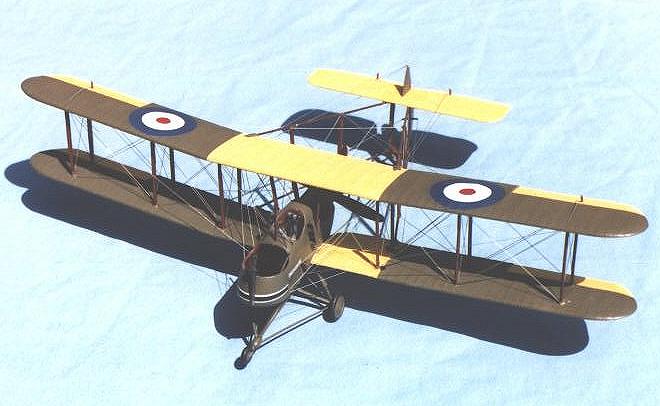
Aeroclub 1/48 F.E.2b
Media: limited-run injection molded plastic with white metal detail parts.
Decals: "Zanzibar No. 1/The Scotch Express," 25 Squadron, 1916.
Built by: Tom Cleaver

The Royal Aircraft Factory F.E.2b (F.E. for "Fighting Experimental," a misnomer if ever there was one) is one of the two airplanes (the other being the B.E.2 series) one describes with the term "Fokker Fodder." Indeed, in early 1916 against the Eindekker and then late 1916 and 1917 against the Albatros, the squadrons flying the F.E.2 suffered apalling losses. In 1917 it became a night bomber and crew survivability went way up. When one considers that in order to defend against a rear attack the gunner had to stand on his cockpit still and strap himself to the post the Lewis gun sat atop of in order to fire over the wing and around the prop , while the pilot tried whatever maneuvers this crate was capable of, it is these young men who deserve praise, certainly not those who supplied them with such an awful excuse for an airplane. It should be remembered, however, that it was just such a gunner who shot down Manfred von Richtofen in August 1917, causing the head wound he never really recovered from.
Nevertheless, the F.E.2b is a historically-important World War I aircraft, and one unlikely to ever be touched by another kit manufacturer. This is Aeroclub's first foray into a full injection-molded kit, the comopany being known primarily as one of the best vacuform makers and producers of white metal detail parts. The wings, tail, fuselage and wheels are injection-molded plastic. All struts, landing gear, the engine and propeller are white metal. As a pusher with "birdcage" rear fuselage, the kit is daunting to anyone, and makes up into one model you will handle infrequently, as it defines the world "fragile."
The model is painted "PC-10" on the upper surfaces and Gunze Sanyo "sail color" on the lowers and for the other areas of clear-doped fabric. The decals are from the kit and up to Aeroclub's usual quality. I used SuperScale's "dark wood pattern" decal sheet to turn the white metal struts into wood, and .008" brass wire painted silver for all the rigging. This is the most "birdcage" model I have built, and while it took about 25 hours to build the model, it took four days with breaks to preserve my eyesight and sanity to rig it. Once completed, it is worth every minute, so far as I am concerned.
With this and the R.E.8, Aeroclub has gone far in bringing important World War I airplanes to the modeller. I hear their next is a Bristol Fighter and I await it with bated breath. I would not recommend this to anyone but a confirmed World War I fanatic, but then, no one who wasn't would even think of touching it. A model that's worth the effort.
Copyright ModelingMadness.com. All rights reserved. No reproduction in part or in whole without express permission.